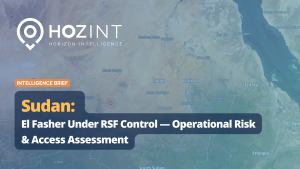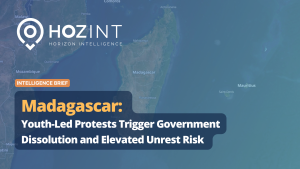Key points
-
Youth-led protests surged after a nationwide social-media ban; violence left ~19–25 dead and hundreds injured, mainly in Kathmandu.
-
Prime Minister K.P. Sharma Oli resigned on 9 September 2025 amid public fury and arson attacks on state buildings, including parliament.
-
Army deployed under curfew; airports and borders faced temporary disruption as flights were cancelled and then gradually resumed.
-
Authorities lifted the social-media ban after the bloodshed, but sporadic violence, arrests, and security operations continued.
Event description
When: 7–10 September 2025, with the deadliest clashes and political climax on 9–10 September.
What: Mass, largely youth-driven demonstrations against corruption and inequality escalated after the government blocked 26 major social-media platforms. Protests turned violent, leading to arson at government buildings (including parliament), dozens of deaths, and a nationwide security response.
Who: Generation-Z activists and civil society groups; state security forces; Prime Minister K.P. Sharma Oli (resigned); the Nepal Army (deployed to restore order). Emerging interlocutors include legal luminaries proposed for a caretaker role.
Where: Kathmandu (parliament, government quarter, PM’s residence), with protests and unrest reported nationwide; aviation disruption centered on Tribhuvan International Airport (KTM).
Why: Long-standing frustration over corruption, unemployment, and elite power-sharing collided with an abrupt social-media blackout seen as authoritarian overreach.
How: Rapid mobilization via remaining channels and offline networks; mass marches converged on central Kathmandu; confrontations with police escalated into lethal force and arson. The government reversed the ban, but only after fatalities and the PM’s resignation.
Analysis
Public discontent in Nepal moved from simmering frustration to open revolt within days, with grievances that had accumulated over corruption, economic stagnation, and entrenched political patronage suddenly coalescing into mass action. The government’s abrupt decision to block access to 26 major social-media platforms acted as the catalyst, stripping younger citizens of the very tools they relied upon for communication and mobilization. Instead of suppressing dissent, the blackout intensified perceptions of authoritarian overreach and galvanized Generation-Z activists to take to the streets. What began as anger over restricted expression quickly evolved into a broader confrontation with the state, transforming latent disaffection into a nationwide movement challenging the legitimacy of the political order.
Tactically, protesters adapted quickly—shifting platforms, using VPNs, and organizing via alternative channels—while physically concentrating on symbolic nodes of power (parliament, party offices). Security forces’ response escalated from crowd control to lethal force, producing at least 19 fatalities in early counts (some outlets report higher), and tipping public sentiment decisively against the government. The subsequent arson attacks on parliament and senior leaders’ homes were both a manifestation of rage and a failure of perimeter security during a known high-risk period.
Politically, the tipping point was the conjunction of casualties and a perceived assault on civil liberties. Oli’s resignation—after previous stints marked by nationalist rhetoric and centralized control—signals both elite fragmentation and the rise of youth-centric narratives. Names floated for a caretaker transition (e.g., respected judicial figures) indicate a search for neutral authority while parties recalibrate. Given Nepal’s history of protest-driven change (from the 2006 people’s movement to periodic anti-corruption surges), this episode fits a pattern where governance crises accelerate when coercive fixes collide with legitimacy deficits.
Disruptions:
-
Security: Indefinite or night curfews in Kathmandu; soldiers guarding institutions; rolling arrests and checkpoints likely for days.
-
Aviation: Tribhuvan International Airport saw blanket cancellations on 9 September; phased reopening announced on 10 September with continued airline-specific cancellations. Expect residual delays, diversions, and a backlog.
-
Digital: The social-media ban has been lifted, but intermittent throttling and platform instability may persist as authorities secure the information space.
Travel advice:
-
Avoid protest hubs around Singha Durbar/parliament, key party offices, and downtown Kathmandu; comply with curfew and military instructions. Carry ID at all times.
-
Reconfirm flights with airlines for all legs involving KTM; expect cancellations and rolling schedule changes despite the official reopening.
-
Monitor embassy advisories and local media; reconsider non-essential movement until curfews ease and security cordons are lifted.
Forecast
Short term (days–weeks): Expect sporadic clashes and arson attempts as fringe actors test security perimeters. Curfews will likely transition from blanket to targeted night-time restrictions. A caretaker arrangement—potentially fronted by a non-partisan figure—could stabilize the streets if paired with credible timelines for reform and elections. Aviation should normalize within a week if no fresh shocks occur, but international carriers may hedge capacity.
Medium term (1–3 months): Momentum shifts to institutional arenas: inquiries into protest deaths, partial rollback or codification of digital-governance rules, and anti-corruption pledges framed for youth constituencies. The risk of coalition deadlock is high; failure to demonstrate tangible reforms could trigger renewed mobilization on sensitive dates or after adverse court decisions. Regional stakeholders—especially India—will nudge for rapid stabilization given cross-border travel and trade.
Risk flags: Another platform clampdown, heavy-handed policing during memorials, or perceived impunity for security abuses could reignite mass turnout. Conversely, inclusion of youth voices in a transition roadmap and transparent handling of casualties would reduce tail-risk of another spiral.



